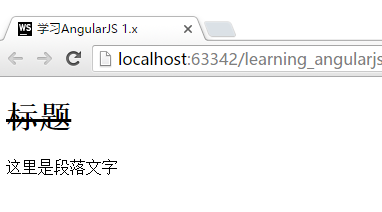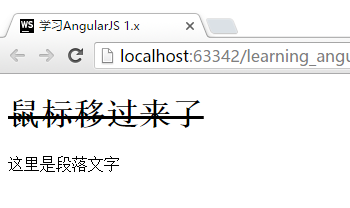- 让Directive动起来
link()elementelement与jQuery的关系- 在AngularJS中使用jQuery
- 实际体验
element的功能 - 在
element上绑定鼠标移入移出时的变化效果
让Directive动起来link()
在前面几节中,我们都是在学习如何配置Directive。下面,我们将开始学习Directive最灵活的部分,link()函数。
link()函数的基本使用方法如下:
App.directive("formDirective", function () {return {restrict: "A",scope:{a:"=",b:"=",c:"="},link: function(scope, element, attrs){console.log(scope);console.log(JSON.stringify(element));console.log(JSON.stringify(attrs));}}});
link()带有三个参数,scope,element,attrs。为了更好的了解link函数三个参数的意义,函数中加上了日志输出的console.log的命令。
scope未加上JSON.stringify转变为json格式输出,是因为scope本身涉及循环引用,因此无法转化为json。
对应的HTML代码:
<div form-directive a="1" b="2" c="3"></div>
在Chrome的”开发者工具”的控制台中,我们可以看到如下结果:
Scope{$id: 3, $$childTail: null, $$childHead: null, $$prevSibling: null, $$nextSibling: null…}
//element{"0":{"ng339":7},"length":1}//attrs{"$attr":{"formDirective":"form-directive","a":"a","b":"b","c":"c"},"$$element":[{"ng339":7},1],"formDirective":"","a":"1","b":"2","c":"3"}
在这里,我们最主要的是观察最下方的attrs部分。我们可以看到,在这个Directive元素中传入的数据,都可以通过attrs获取到,这也是我们在link()中获取数据的主要方法。
element
从element被转义成json的文本中很难获取任何实质的信息,但是,这里才是整个Directive中的核心部分。
element与jQuery的关系
在Directive中,我们不免需要对页面元素进行操作。为了提供这项功能,AngularJS几乎原版搬运了jQuery操作元素的功能,他们称之为”jQuery Lite”(jqLite)。
AngularJS通过jqLite的调用方法angular.element,实现了jQuery中的大部分常用功能。也就是,我们可以在获取了element参数后,调用jQuery常用的语法,如bind(),addClass(),removeClass()等来直接对元素进行操作,实现我们期望的功能。
同时,如果你希望在AngularJS中直接使用完整的jQuery也是非常容易的。只需要安装jQuery,并在index.html中,保证在angular.js引入之前引入jQuery.js。AngularJS会自动将angular.element绑定到jQuery上。也就是,在Directive中,会自动使用jQuery来解析界面元素,我们获取的element会自动变为jQuery对象。
在AngularJS中使用jQuery
安装和使用jQuery共有两步:
- 通过
bower安装jQuery
bower install jquery --save
- 在
index.html中引入jquery.js
<!-- 保证在angular.js之前引入jquery.js --><script type="text/javascript" src="components/jquery/dist/jquery.js"></script><script type="text/javascript" src="components/angular/angular.js"></script>
实际体验element的功能
我们在引入jQuery后,可以通过如下代码查看效果:
这里需要注意的是,使用jqLite的方法和以下代码中使用的方法是不一样的,因为jqLite不支持通过标签方式获取子元素。如果您有兴趣学习jqLite的使用方法(并且拥有一定的英文阅读能力),可以在这里查看官方文档。
App.directive("formDirective", function () {return {restrict: "A",template:"<h1>标题</h1><p>这里是段落文字</p>",link: function(scope, element, attrs){element.children("h1").addClass("strike");}}});
<div ng-controller="FirstCtrl"><div form-directive></div></div>

在element上绑定鼠标移入移出时的变化效果
App.directive("formDirective", function () {return {restrict: "A",template:"<h1>标题</h1><p>这里是段落文字</p>",link: function(scope, element, attrs){element.children("h1").bind("mouseenter", function(){element.children("h1").addClass("strike");element.children("h1").text("鼠标移过来了");});element.children("h1").bind("mouseleave", function(){element.children("h1").removeClass("strike");element.children("h1").text("鼠标移开了");})}}});
运行时,当鼠标移动到标题上,则标题文字会变化成”鼠标移过来了”,并加上删除线效果;当鼠标移开,则文字会变为”鼠标移开了”。

因为主要是jQuery的用法,更多的实际应用就不在本书中详述了。如果有兴趣学习jQuery,您可以通过上网搜索或者购买书籍的方式来学习。
